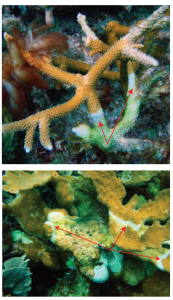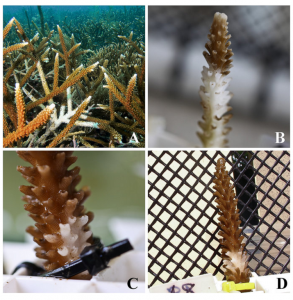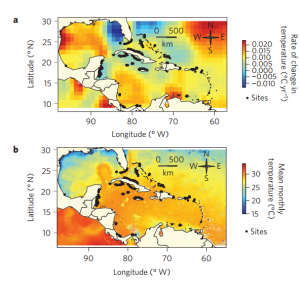Coral reefs are resilient yet gentle ecosystems that are affected by several diseases. They have overtaken the Caribbean reefs and have become a serious deteriorating factor. In my last post I talked about the effect of the Black Band Disease on Caribbean corals. Today, I would like to focus on another disease that also leaves its detrimental “mark”.

Figure 1. The red arrows are pointing towards the white band (the exposed skeleton). The stark contrast between the healthy coral and the affected area are seen. Copyright: Randall, C.J.& Woesik, R. van. “Contemporary white-band disease in Caribbean corals driven by climate change.” DOI: 10.1038 2
The White Band Disease (WBD) haunts the coral reefs and targets Acropora Palmata (Elkhorn coral) and the Acropora cervicornis (Staghorn coral). It peels away the coral tissue leaving the white skeleton exposed, creating the infamous “white band” as seen in Figure 1.1 What’s worse is that the coral is left vulnerable making it an easy target for algae to latch on and grow.1 The algae then covers the coral skeleton and the coral has no chance to combat the disease or regrow.
You must be thinking “Oh it’s not that serious, it only affects two species of corals”…but that could not be further from the truth! These two species are major coral reef builders that area an important component for the framework of Caribbean coral reef ecosystems.2 Due to disease attacks in recent decades, populations in various regions of the Caribbean have declined by more than 90%.2 Sadly, the Elkhorn and Staghorn coral have been placed on the official endangered species list.3 To further deepen the blow, there has been no sign of any the coral recovering nor has a successful intervention been implemented.

Figure 2. Staghorn coral pictured. a) Coral affected by WBD in the ocean b) Induced WBD in a lab c) Demonstrating snail predation d) Lesion imitating what occurs with snail predation
Copyright: Gignoux-Wolfsohn, S. A.; Marks, Christopher J.; Vollmer, Steven V. “White Band Disease transmission in the threatened coral, Acropora cervicornis.” doi:10.1038/srep00804 4
WBD is transmitted quite easily from coral to coral. If healthy coral comes in contact with the infected coral, they will also be targeted by the disease. 3 Two main ways that the disease is spread is through animals or simply through contaminated water.4 Snails who rely on corals for their main source of food have become key players in the spread of WBD.3 In Figure 2, we can see qualitative data from an experiment that tested the effects of the snails eating habits on the coral.
The culprit has yet to be identified, but scientists remain on the lookout. Scientists are almost sure that it is caused by a bacterial infection but the exact pathogen remains unknown. 3 The deterioration in the coral is caused by an attack of microbes but what remains unclear is where the microbes come from and how they are propagated. There is a theory that the bacteria already exist within the coral, but under extreme environmental conditions they turn against, and attack their coral host.2
Furthermore, Marine scientists have various hypothesis of factors that perpetuate the corals vulnerability to this disease. Possibilities range from an overpopulation of algae to changes in Sea Surface Temperature (SST) due to climate change.1 In the Caribbean there has been a steady increase in SST throughout the years, and this progression is seen in Figure 3 below. There have been studies that confirm that climate change and the ever increasing temperatures of the ocean water play a crucial role in the escalation of WBD.2

Figure 3. Sea Surface Temperature (SST) of the Caribbean. a) Average rate of change in SST FROM 1967-2004 b) Mean SST for March 1982
Copyright: Randall, C.J.& Woesik, R. van. “Contemporary white-band disease in Caribbean corals driven by climate change.” DOI: 10.1038 2
It is evident that scientists are working hard to add to the existing research and hypothesis in order to better understand this disease that is harming the beloved Caribbean coral reefs. However, conscientious choices from everyone else will also help in this fight to protect coral reefs. Without a doubt, climate change is a serious issue that affects various habitats and ecosystems. So I encourage you to reduce your greenhouse gas emissions by recycling, carpooling and making other eco-friendly decisions!
- “Coral Diseases.”Florida Museum of Natural History. University of Florida, n.d. Web. 22 Mar. 2017. <https://www.flmnh.ufl.edu/southflorida/habitats/corals/diseases/>.
- Randall, C.J.& Woesik, R. van. “Contemporary white-band disease in Caribbean corals driven by climate change.” Nature Climate Change 4 (2015): 375-379. ProQuest. Web. 22 Mar. 2017. DOI: 10.1038
- Kline, David I. & Vollmer, Steven V. “White Band Disease (type I) of Endangered Caribbean Acroporid Corals is Caused by Pathogenic Bacteria” Scientific Reports. 7 (2011). Nature.com. Web. 22 Mar. 2017. doi:10.1038/srep0000
- Gignoux-Wolfsohn, S. A.; Marks, Christopher J.; Vollmer, Steven V. “White Band Disease transmission in the threatened coral, Acropora cervicornis.” Scientific Reports 804 (2012). Nature.com. Web. 22 Mar. 2017. doi:10.1038/srep00804

